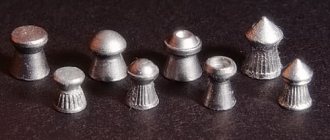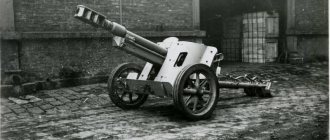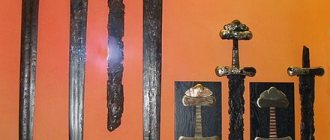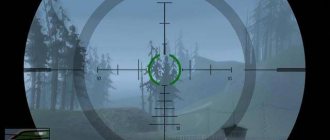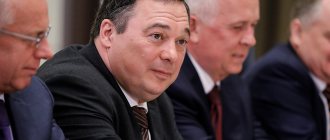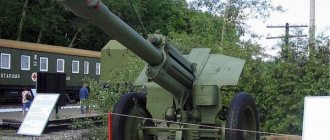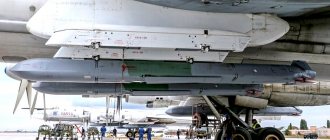| Su-35 | |
| Su-35 at MAKS-2009 | |
| Type | multi-role fighter |
| Developer | Sukhoi Design Bureau |
| Manufacturer | KnAAZ named after Yu. A. Gagarin |
| First flight | February 19, 2008 |
| Start of operation | February 12, 2014 |
| Status | produced, operated |
| Main operators | Russian Aerospace Forces |
| Years of production | since 2008 |
| Units produced | 48 (as of 2020) [1] |
| Unit cost | about 2 billion rubles [2] |
| Basic model | Su-27 |
| Images on Wikimedia Commons | |
Su-35Su-35
Su-35
(according to NATO codification:
Flanker-E+
[3]) is a Russian multi-role super-maneuverable fighter of the 4++ generation, without PGO, with thrust vector control (TCV) engines.
Developed by the Sukhoi Design Bureau. The serial fighter for the Russian Aerospace Forces is called Su-35S
.
Previously, the Su-27M aircraft was exhibited at international air shows under the symbol “Su-35”.
“Generation 4++” is conditional and only indicates that the overall characteristics of the fighter are very close to the characteristics of the fifth generation fighter. With the exception of low visibility technology and AFAR, it satisfies most of the requirements for 5th generation aircraft[4].
Content
- 1. History
- 2 Design 2.1 Airframe
- 2.2 Engines
- 2.3 Avionics
- 4.1 Technical specifications
Story
The Su-35 is a deep modernization of the T-10S platform (initially the modernization program for the Su-27 aircraft was called “Su-35BM” - a major modernization)[8].
The assembly of the first prototype Su-35 aircraft (no. 901) was completed in the summer of 2007 at KnAAPO im. Yu. A. Gagarin", after which the car was presented at the MAKS-2007 air show in a static parking lot.
The first flight of the experimental Su-35 with NPO Saturn AL-41F1S engines took place on February 19, 2008 at the Flight Research Institute named after. Gromova. The plane was piloted by Honored Test Pilot of the Russian Federation Sergei Bogdan.
In 2009, the first contract was concluded for the supply of 48 Su-35S[9] fighters to the Russian Air Force for a total amount of 66 billion rubles. in 2012-2015. By the end of 2020, 48 fighters were manufactured[3]. In December 2015, a second contract was signed for the supply of 50 units to the Russian Aerospace Forces until 2020 in the amount of 100 billion rubles.
In November 2020, the Indonesian government approved the purchase of 12 Su-35 multirole fighters. In 2020, an agreement was signed for the supply of 24 Su-35 multirole fighters to China; transferred in 2016 [ specify
] first 4 cars.
Creating a model
Russian designers began working on the creation of the first trial model in 2006. According to the previously approved plan, testing of the test sample was supposed to begin at the end of 2007, but the deadline had to be postponed by almost a whole year.
The performance characteristics of the Su-35 pleasantly surprised everyone present at the site of the first test flight. And the next day, military equipment was presented to V.V. Putin for review. And in the second trial test, air transport was able to confirm its incredible technical capabilities.
Considering the obvious advantages of the new fighter, it was decided to conclude a deal to purchase a large batch of military fighters, which in the future will be able to replenish the Russian Air Force. Initially, the cost of the Su-35 was agreed upon between the aviation and military Russian departments. Having found a compromise regarding the cost of military equipment, the business partners signed an impressive contract for the creation of more than 47 units of aircraft over 3 years, starting in 2012 and ending in 2020.
The Sukhoi automobile industrial enterprise successfully coped with the task assigned to it - in 2020, the Russian army had more than 64 Su-35S units in service.
Su-35 cockpit
Design
Russian Su-35 (below) and Su-57 (above) - a fifth-generation fighter in flight.
The Su-35 fighter is a deep modernization of the Su-27. It has a largely new reinforced airframe[4][5][6]; unlike the old Su-27M, it does not have a front horizontal tail unit (FH) and a brake flap (braking during landing is carried out by deflecting the rudders from the longitudinal axis).
According to a statement from the Sukhoi Design Bureau, the assigned service life of the Su-35 (except for engines) is 6,000 flight hours or 30 years. The declared assigned resource of the engines is 4000 hours.
Glider
See Su-27 airframe
Su-35 airframe: the edges of the airframe are covered with materials that reduce the effective dispersion area. The cabin canopy has a conductive coating.
Engines
Engines “product 117S” with UVT
The Su-35 is equipped with two AL-41F1S bypass turbojet engines developed by the Design Bureau named after. A. Lyulka - a branch of PJSC "ODK-UMPO" with an afterburner, a plasma ignition system and an all-angle controlled thrust vector (UVT)[5][6].
These engines are a “simplified” version of the AL-41F1, the engine of the first stage of the fifth generation fighter. The AL-41F1S is distinguished from it by reduced afterburning and non-afterburning thrust and the use of an electronic-mechanical control system. The afterburning thrust of each AL-41F1S engine is 14,500 kgf, in non-afterburning mode the maximum thrust is 8800 kgf. In order to increase the number of angles of engine thrust deflection and create a pseudo-all-perspectivity, the rotation axes of the deflected nozzles are tilted, which is clearly visible in the photograph (the nozzles are deflected downward-inward and upward-outward).
- Service life 4000 hours, time between repairs 1000 hours[10].
Radar N035 Irbis with PFAR Su-35S of the Russian Air Force in the coloring adopted from 2010 to 2013
VGTD TA14-130-35
— auxiliary (APU) gas turbine engine with an equivalent power of 105 kW. Provides air conditioning for the cabin and aircraft compartments and power supply with alternating current 200/115 V with a power of up to 30 kVA for on-board consumers[11].
Avionics
The Su-35S has the IUS-35 information and control system.[12]
A radar with a phased array antenna “N035 Irbis” was installed, which has a target detection range with an ESR of 0.01 m² up to 100 km; EPR 0.1 m² up to 160 km; EPR 1 m² up to 270 km; ESR 3 m² up to 400 km L-band antenna system, which has a target detection range with ESR 0.01 m² up to 130 km[13]. In addition to radar equipment, an optical-location station and OEIS are used.
Instead of traditional PVD rods, sensors of the VSP-35 SI system that do not protrude into the flow were used, which made it possible to get rid of the “patch” on the nose cone that was opaque to radio waves and to level the radar sensitivity diagram.
The aircraft is equipped with electronic warfare equipment, and can also be equipped with group electronic defense stations.
The cockpit is equipped with three displays with the ability to operate in multi-screen mode and a holographic indicator on the windshield.
The aircraft is equipped with an L-150-35 radiation warning system (version L-150 (SPO)).
Equipped with an optical data transmission system for communication between aircraft of the group when flying in radio silence mode. The receivers/transmitters of this system in the form of short stripes on the sides of the cockpit, on the keels and wingtips are one of the most noticeable external differences from previous modifications.
An excerpt characterizing the Su-35
An old man, as experienced in court affairs as in military matters, that Kutuzov, who in August of the same year was chosen commander-in-chief against the will of the sovereign, the one who removed the heir and the Grand Duke from the army, the one who, with his power, in opposition the will of the sovereign, ordered the abandonment of Moscow, this Kutuzov now immediately realized that his time was over, that his role had been played and that he no longer had this imaginary power. And he understood this not just from court relationships. On the one hand, he saw that military affairs, the one in which he played his role, was over, and he felt that his calling had been fulfilled. On the other hand, at the same time he began to feel physical fatigue in his old body and the need for physical rest. On November 29, Kutuzov entered Vilna - his good Vilna, as he said. Kutuzov was governor of Vilna twice during his service. In the rich, surviving Vilna, in addition to the comforts of life that he had been deprived of for so long, Kutuzov found old friends and memories. And he, suddenly turning away from all military and state concerns, plunged into a smooth, familiar life as much as he was given peace by the passions seething around him, as if everything that was happening now and was about to happen in the historical world did not concern him at all. Chichagov, one of the most passionate cutters and overturners, Chichagov, who first wanted to make a diversion to Greece, and then to Warsaw, but did not want to go where he was ordered, Chichagov, known for his courage in speaking to the sovereign, Chichagov, who considered Kutuzov benefited himself, because when he was sent in the 11th year to conclude peace with Turkey in addition to Kutuzov, he, making sure that peace had already been concluded, admitted to the sovereign that the merit of concluding peace belonged to Kutuzov; This Chichagov was the first to meet Kutuzov in Vilna at the castle where Kutuzov was supposed to stay. Chichagov in a naval uniform, with a dirk, holding his cap under his arm, gave Kutuzov his drill report and the keys to the city. That contemptuously respectful attitude of the youth towards the old man who had lost his mind was expressed to the highest degree in the entire address of Chichagov, who already knew the charges brought against Kutuzov. While talking with Chichagov, Kutuzov, among other things, told him that the carriages with dishes captured from him in Borisov were intact and would be returned to him. – C'est pour me dire que je n'ai pas sur quoi manger... Je puis au contraire vous fournir de tout dans le cas meme ou vous voudriez donner des diners, [You want to tell me that I have nothing to eat. On the contrary, I can serve you all, even if you wanted to give dinners.] - Chichagov said, flushing, with every word he wanted to prove that he was right and therefore assumed that Kutuzov was preoccupied with this very thing. Kutuzov smiled his thin, penetrating smile and, shrugging his shoulders, answered: “Ce n'est que pour vous dire ce que je vous dis.” [I only want to say what I say.] In Vilna, Kutuzov, contrary to the will of the sovereign, stopped most of the troops. Kutuzov, as his close associates said, had become unusually depressed and physically weakened during his stay in Vilna. He was reluctant to deal with the affairs of the army, leaving everything to his generals and, while waiting for the sovereign, indulged in an absent-minded life. Having left St. Petersburg with his retinue - Count Tolstoy, Prince Volkonsky, Arakcheev and others, on December 7, the sovereign arrived in Vilna on December 11 and drove straight up to the castle in a road sleigh. At the castle, despite the severe frost, stood about a hundred generals and staff officers in full dress uniform and an honor guard from the Semenovsky regiment. The courier, who galloped up to the castle in a sweaty troika, ahead of the sovereign, shouted: “He’s coming!” Konovnitsyn rushed into the hallway to report to Kutuzov, who was waiting in a small Swiss room. A minute later, the thick, large figure of an old man, in full dress uniform, with all the regalia covering his chest, and his belly pulled up by a scarf, pumping, came out onto the porch. Kutuzov put his hat on the front, picked up his gloves and sideways, stepping with difficulty down the steps, stepped down and took in his hand the report prepared for submission to the sovereign. Running, whispering, the troika still desperately flying by, and all eyes turned to the jumping sleigh, in which the figures of the sovereign and Volkonsky were already visible. All this, out of a fifty-year habit, had a physically disturbing effect on the old general; He hurriedly felt himself with concern, straightened his hat, and at that moment the sovereign, emerging from the sleigh, raised his eyes to him, cheered up and stretched out, submitted a report and began to speak in his measured, ingratiating voice. The Emperor glanced quickly at Kutuzov from head to toe, frowned for a moment, but immediately, overcoming himself, walked up and, spreading his arms, hugged the old general. Again, according to the old, familiar impression and in relation to his sincere thoughts, this hug, as usual, had an effect on Kutuzov: he sobbed. The Emperor greeted the officers and the Semenovsky guard and, shaking the old man’s hand again, went with him to the castle. Left alone with the field marshal, the sovereign expressed his displeasure to him for the slowness of the pursuit, for the mistakes in Krasnoye and on the Berezina, and conveyed his thoughts about the future campaign abroad. Kutuzov made no objections or comments. The same submissive and meaningless expression with which, seven years ago, he listened to the orders of the sovereign on the Field of Austerlitz, was now established on his face. When Kutuzov left the office and walked down the hall with his heavy, diving gait, head down, someone’s voice stopped him. “Your Grace,” someone said. Kutuzov raised his head and looked for a long time into the eyes of Count Tolstoy, who stood in front of him with some small thing on a silver platter. Kutuzov did not seem to understand what they wanted from him. Suddenly he seemed to remember: a barely noticeable smile flashed on his plump face, and he, bending low, respectfully, took the object lying on the platter. This was George 1st degree. The next day the field marshal had a dinner and a ball, which the sovereign honored with his presence. Kutuzov was awarded George 1st degree; the sovereign showed him the highest honors; but the sovereign’s displeasure against the field marshal was known to everyone. Decency was observed, and the sovereign showed the first example of this; but everyone knew that the old man was guilty and no good. When at the ball Kutuzov, according to Catherine’s old habit, upon the Emperor’s entrance into the ballroom, ordered the taken banners to be laid down at his feet, the Emperor frowned unpleasantly and uttered words in which some heard: “old comedian.” The sovereign's displeasure against Kutuzov intensified in Vilna, especially because Kutuzov obviously did not want or could not understand the significance of the upcoming campaign. When the next morning the sovereign said to the officers gathered at his place: “You saved more than just Russia; you saved Europe,” everyone already understood that the war was not over. Only Kutuzov did not want to understand this and openly expressed his opinion that a new war could not improve the situation and increase the glory of Russia, but could only worsen its position and reduce the highest degree of glory on which, in his opinion, Russia now stood. He tried to prove to the sovereign the impossibility of recruiting new troops; spoke about the difficult situation of the population, about the possibility of failures, etc. In such a mood, the field marshal, naturally, seemed to be only a hindrance and a brake on the upcoming war. To avoid clashes with the old man, a way out was found by itself, which consisted in, as at Austerlitz and as at the beginning of the campaign under Barclay, to remove from under the commander-in-chief, without disturbing him, without announcing to him that the ground of power on which he stood , and transfer it to the sovereign himself. For this purpose, the headquarters was gradually reorganized, and all the significant strength of Kutuzov’s headquarters was destroyed and transferred to the sovereign. Tol, Konovnitsyn, Ermolov - received other appointments. Everyone said loudly that the field marshal had become very weak and was upset about his health. He had to be in poor health in order to transfer his place to the one who took his place. And indeed, his health was poor. Just as naturally, and simply, and gradually, Kutuzov came from Turkey to the treasury chamber of St. Petersburg to collect the militia and then into the army, precisely when he was needed, just as naturally, gradually and simply now, when Kutuzov’s role was played, to take his place a new, needed figure appeared. The war of 1812, in addition to its national significance dear to the Russian heart, should have had another – European one. The movement of peoples from West to East was to be followed by the movement of peoples from East to West, and for this new war a new figure was needed, with different properties and views than Kutuzov, driven by different motives. Alexander the First was as necessary for the movement of peoples from east to west and for the restoration of the borders of peoples as Kutuzov was necessary for the salvation and glory of Russia. Kutuzov did not understand what Europe, balance, Napoleon meant. He couldn't understand it. The representative of the Russian people, after the enemy was destroyed, Russia was liberated and placed at the highest level of its glory, the Russian person, as a Russian, had nothing more to do. The representative of the people's war had no choice but death. And he died. Pierre, as most often happens, felt the full weight of the physical deprivations and stresses experienced in captivity only when these stresses and deprivations ended. After his release from captivity, he came to Orel and on the third day of his arrival, while he was going to Kyiv, he fell ill and lay sick in Orel for three months; As the doctors said, he suffered from bilious fever. Despite the fact that the doctors treated him, bled him and gave him medicine to drink, he still recovered. Everything that happened to Pierre from the time of his liberation until his illness left almost no impression on him. He remembered only grey, gloomy, sometimes rainy, sometimes snowy weather, internal physical melancholy, pain in his legs, in his side; remembered the general impression of misfortune and suffering of people; he remembered the curiosity that disturbed him from the officers and generals who questioned him, his efforts to find a carriage and horses, and, most importantly, he remembered his inability to think and feel at that time. On the day of his release, he saw the corpse of Petya Rostov. On the same day, he learned that Prince Andrei had been alive for more than a month after the Battle of Borodino and had only recently died in Yaroslavl, in the Rostov house. And on the same day, Denisov, who reported this news to Pierre, between conversations mentioned Helen’s death, suggesting that Pierre had known this for a long time. All this seemed strange to Pierre at the time. He felt that he could not understand the meaning of all this news. He was only in a hurry then, as quickly as possible, to leave these places where people were killing each other, to some quiet refuge and there to come to his senses, rest and think about all the strange and new things that he had learned during this time. But as soon as he arrived in Orel, he fell ill. Waking up from his illness, Pierre saw around him his two people who had arrived from Moscow - Terenty and Vaska, and the eldest princess, who, living in Yelets, on Pierre's estate, and having learned about his release and illness, came to him to visit behind him. During his recovery, Pierre only gradually unaccustomed himself to the impressions of the last months that had become familiar to him and got used to the fact that no one would drive him anywhere tomorrow, that no one would take his warm bed away, and that he would probably have lunch, tea, and dinner. But in his dreams, for a long time he saw himself in the same conditions of captivity. Pierre also gradually understood the news that he learned after his release from captivity: the death of Prince Andrei, the death of his wife, the destruction of the French. A joyful feeling of freedom - that complete, inalienable, inherent freedom of man, the consciousness of which he first experienced at his first rest stop, when leaving Moscow, filled Pierre's soul during his recovery. He was surprised that this internal freedom, independent of external circumstances, now seemed to be abundantly, luxuriously furnished with external freedom. He was alone in a strange city, without acquaintances. Nobody demanded anything from him; they didn’t send him anywhere. He had everything he wanted; The thought of his wife that had always tormented him before was no longer there, since she no longer existed. - Oh, how good! How nice! - he said to himself when they brought him a cleanly set table with fragrant broth, or when he lay down on a soft, clean bed at night, or when he remembered that his wife and the French were no more. - Oh, how good, how nice! - And out of old habit, he asked himself: well, then what? What will i do? And immediately he answered himself: nothing. I will live. Oh, how nice! The very thing that tormented him before, what he was constantly looking for, the purpose of life, now did not exist for him. It was no coincidence that this sought-after goal of life did not exist for him at the present moment, but he felt that it did not and could not exist. And it was this lack of purpose that gave him that complete, joyful consciousness of freedom, which at that time constituted his happiness. He could not have a goal, because he now had faith - not faith in some rules, or words, or thoughts, but faith in a living, always felt God. Previously, he sought it for the purposes that he set for himself. This search for a goal was only a search for God; and suddenly he learned in his captivity, not in words, not by reasoning, but by direct feeling, what his nanny had told him long ago: that God is here, here, everywhere. In captivity, he learned that God in Karataev is greater, infinite and incomprehensible than in the Architect of the universe recognized by the Freemasons. He experienced the feeling of a man who had found what he was looking for under his feet, while he strained his eyesight, looking far away from himself. All his life he had been looking somewhere, over the heads of the people around him, but he should have not strained his eyes, but only looked in front of him. He had not been able to see before the great, incomprehensible and infinite in anything. He just felt that it must be somewhere and looked for it. In everything close and understandable, he saw something limited, petty, everyday, meaningless. He armed himself with a mental telescope and looked into the distance, to where this small, everyday thing, hiding in the fog of the distance, seemed great and endless to him only because it was not clearly visible. This is how he imagined European life, politics, Freemasonry, philosophy, philanthropy. But even then, in those moments that he considered his weakness, his mind penetrated into this distance, and there he saw the same petty, everyday, meaningless things. Now he had learned to see the great, the eternal and the infinite in everything, and therefore naturally, in order to see it, to enjoy its contemplation, he threw down the pipe into which he had been looking until now through the heads of people, and joyfully contemplated the ever-changing, ever-great world around him. , incomprehensible and endless life. And the closer he looked, the more calm and happy he was. Previously, the terrible question that destroyed all his mental structures was: why? did not exist for him now. Now to this question - why? a simple answer was always ready in his soul: because there is a God, that God, without whose will a hair will not fall from a man’s head. Pierre has hardly changed in his external techniques. He looked exactly the same as he had been before. Just as before, he was distracted and seemed preoccupied not with what was in front of his eyes, but with something special of his own. The difference between his previous and present state was that before, when he forgot what was in front of him, what was said to him, he, wrinkling his forehead in pain, seemed to be trying and could not see something far away from him . Now he also forgot what was said to him and what was in front of him; but now, with a barely noticeable, seemingly mocking, smile, he peered at what was in front of him, listened to what was being said to him, although obviously he saw and heard something completely different. Before, although he seemed to be a kind person, he was unhappy; and therefore people involuntarily moved away from him. Now a smile of the joy of life constantly played around his mouth, and his eyes shone with concern for people - the question: are they as happy as he is? And people were pleased in his presence.
Modifications
Su-35BM
— the original name of the Su-27 aircraft modernization program was “big modernization.” Later it went into production as the Su-35.
Su-35C
— a deeply modernized super-maneuverable multifunctional fighter of the “4++” generation[4][5][6]. It uses fifth-generation technologies, providing superiority over fighters of a similar class[5]. Distinctive features of the aircraft are a new avionics complex based on a digital information and control system that integrates on-board equipment systems, a new radar with a phased array antenna with a long detection range of air targets with an increased number of simultaneously tracked and fired targets, new engines with increased thrust and rotary thrust vector[4][5][6]. The Su-35S made its first flight in February 2008.
Background of development
In the early 1980s, while the Su-27 was still being mastered by the Soviet Air Force, its general designer Pavel Sukhoi was already planning to develop a modernized version. Originally designated the Su-27M, it was equipped with significantly improved avionics, making it the best fighter of its era. It was also equipped with a more diverse set of weapons, which allowed the Su-27M (see photo below) to carry out missions to engage ground targets.
The modernized version was characterized by many changes in aerodynamics, avionics, power plant design, and also had increased payload capacity. High-strength composite materials and aluminum-lithium alloys were used to reduce weight and increase fuel capacity.
The Su-27M aircraft was equipped with a turbojet engine with a thrust of 125 kN, more powerful than that of the Su-27. The Su-27 modernization program itself was designated “Su-35BM”, where the letters meant “major modernization”. Much of what was done during that period was absorbed by the modern Su-35 aircraft, the technical characteristics of which significantly exceed its original Su-27M prototype.
Performance characteristics
Sources:
[14][15][16][17][18].
Su-35S at the celebration of the centenary of the Russian Air Force
Specifications
- Crew:
1 person - Length:
21.9 m - Wingspan:
14.75 m - Height:
5.9 m - Wing area:
62.04 m² - Leading edge sweep angle:
42° - Landing gear:
tricycle, with front strut retractable against flight - Weight: empty:
19,000 kg [
source not specified 2576 days
] - normal take-off weight (2 x R77 + 2 x R-73E):
25,300 kg - maximum take-off weight:
34,500 kg - fuel weight:
11,500 kg
- engine type:
turbojet bypass with afterburner and thrust vector control (TRDDF with OVT)
"AL-41F1S"
2 × 8800 kgf
2 × 14,500 kgf[19]
- thrust vector deflection angles:
±15° in plane
60 °/s
1520 kg
0.7—2 m² (without weapon mounts)[18][
unauthorized source?
]
Images
Su-35
at the MAKS-2009 air show:
- Su-35 (1).jpg
- Su-35 (2).jpg
- Su-35 (3).jpg
- Su-35 (4).jpg
Su-35S
at the celebration of the centenary of the Russian Air Force:
- Su-35S 100th Anniversary of Russian Air Force (1).jpg
- Su-35S 100th Anniversary of Russian Air Force (2).jpg
- Su-35S 100th Anniversary of Russian Air Force (3).jpg
- Su-35S 100th Anniversary of Russian Air Force (4).jpg
- Su-35S 100th Anniversary of Russian Air Force (5).jpg
Flight characteristics
Su-35S at MAKS-2013.
Source: KnAAZ[20]
- Maximum speed: at ground level:
1400 km/h - at altitude:
M=2.25, H=11,000 meters - afterburning:
M=1.1[21]
- Overclocking characteristics
[22]:
Acceleration time at an altitude of 1000 m, with fuel remaining 50% of normal fueling, seconds
| from 600 km/h to 1100 km/h | 13,8 |
| from 1100 km/h to 1300 km/h | 8 |
- Flight range: near the ground (height - 200 m, speed - =0.7):
1580 km - at altitude: without PTB:
3600 km - with 2 PTB-2000 l:
4500 km
20,000 m
280 m/s
- take-off run (full afterburner):
450 m
650 m
- at normal take-off weight:
1,1
0,811
- at normal take-off weight:
410 kg/m²
611 kg/m²
Armament
Su-35S of the Lipetsk Aviation Center January 16, 2020
source
[23][24]
- Cannon:
30 mm aircraft cannon GSh-30-1 150 rounds - Combat load:
8000 kg - Weapon hardpoints
: 12 - Armament: Air-to-air: medium range:
up to 12 x R-77-1; - up to 2 x R-27ET;
- 6 × R-73(RVV-MD)
- Anti-ship missiles:
6 × Kh-31, Kh-35U or 2 × Kh-59M
- 6 × Kh-29T or Kh-38Mxx;
- 6 S-25 (NAR)
Avionics
The Su-35S fighters use the N035 Irbis phased array radar.
Radar characteristics:
- Frequency range:
X (8 - 12 GHz) - PAR diameter:
900 mm - Viewing angles:
±60° (electronic), ±120° (hydraulic) - Average power:
5000 W - Peak Power:
20 000 - Target detection range: with EPR 0.01 m²:
up to 90 km[25] - with an EPR of 0.01 m² at opposite angles of 100 km;
[13] - with EPR 0.1 m² at opposite angles 160 km;
[13] - with EPR 1 m² at opposite angles 270 km;
[13] - with EPR 3 m²: on collision courses:
350-400 km (in a zone of 100 sq. degrees, against the sky) - catch-up:
150 km[26]
- Detection and targeting:
4 ground or 30 air
with missiles with
a semi-active
homing head (R-27R, R-27ER) - no more than
2
targets;
missiles with an active
homing head (R-77, RVV-AE, RVV-SD, R-37) - no more than
8
.
air targets at a range of up to 80 km. The Su-35 has a missile attack warning system (IR sensors).
Purpose
In fact, the Su-30SM fighter is an almost complete copy of the Su-30MKI model, the systems of which were simply adapted for use by the Russian Air Force. The resulting machine is a multi-purpose aircraft. It can conduct air combat, hitting modern enemy fighters, gain air superiority, and strike at stationary or mobile enemy targets. In addition, the characteristics of the Su-30Sm allow it to accompany and cover strike groups of military aviation, provide target designation to the aircraft of its group and counter enemy radar systems. This aircraft can also be used for naval battles, as it is capable of detecting and destroying enemy surface vessels, either independently or as part of a strike group.
Production
In 2009, Sukhoi entered into an agreement with the Ministry of Defense for the supply of 48 Su-35S fighters, with a delivery date of 48 such fighters scheduled to arrive in the Russian Air Force by the end of 2015.
In December 2020, a second contract was signed for the supply of 50 units to the Russian Aerospace Forces until 2020[27].
The exact cost of production of one Su-35 is unknown. However, according to the former commander-in-chief of the Russian Aerospace Forces, Colonel General Viktor Bondarev[28], the cost of one Su-35 exceeds 1 billion rubles.
As of February 2020, the development and state tests of the Su-35S have been completed and more than 60 vehicles are in military service[29]. The first state defense order for 48 units was completed in 2015.[30] The second state defense order for 50 Su-35S was completed by 80% - 40 units (November 2020)[31]. “Russian Knights” - 4 units as of November 2019.
| The information in this article or some sections of it is out of date. You can help the project by updating it and then removing this template. |
Radar and targeting system
In this part, the characteristics of the Su-35 include the presence of an Irbis radar with a passive phased array antenna, which forms an important component of the aircraft's fire control system. The radar is capable of detecting an air target with an area of 3 square meters. m at a distance of 400 km and can provide target designation for 30 air targets, and lead eight of them.
The radar is also capable of reproducing a map of the earth using various modes, including aperture synthesis mode. The Irbis radar is complemented by an optical-electronic targeting system, which uses the functionality of a laser range finder, TV, and infrared target detector.
Export
In November 2020, a contract was signed for the supply of 24 Su-35 fighters to China[32][33]; contract value is about $2.5 billion[34] The last vehicles were delivered to the customer in November 2018[35].
In February 2020, a contract was signed for the supply of 11 fighters to Indonesia; the contract value is $1.1 billion[36]. In October, the Kommersant newspaper reported that the delivery of the Su-35 to Indonesia was being postponed due to pressure on Jakarta from the United States; According to the newspaper, the first planes were supposed to arrive in Indonesia by October, but this did not happen[37]. Later, TASS reported that Su-35 deliveries from the Russian Federation to Indonesia were not scheduled for October[38]. The head of the military department of the republic, Riamizard Riachudu, said that the implementation of the contract will continue despite the sanctions against the Russian Federation[39]. The Indonesian Ambassador to the Russian Federation, Mohamad Wahid Supriyadi, said that the agreement had been signed and deliveries of Su-35 fighter jets to Indonesia could begin in 2020[40]. On March 12, 2020, Bloomberg reported that Indonesia refused to purchase the Su-35 due to US pressure[41][42].
In March 2020, the Kommersant newspaper reported that a contract had been signed for the supply of more than 20 fighters to Egypt; contract value: $2 billion[43] The message was later denied by Rosoboronexport[44].
Malaysia and India can also purchase Su-35 aircraft (the latter is currently holding a tender for the purchase of 114 multirole fighters; the main competitor is the F-15EX[45]), potential customers have become more active after the successful use of this technology by the Russian Aerospace Forces in Syria[ 46].
In service
Operating countries of the Su-35.
- Russian Aerospace Forces 90 units for 2020[47]
- Tver region (Khotilovo), 790 IAP - 12 units as of November 2019.
- Republic of Karelia (Besovets), 159 Guards. IAP - 24 units.
- Khabarovsk Territory (Dzemgi), 23 IAP - 30 units.
- Primorsky Territory (Central Corner), 22 Guards. IAP - 12 units[48].
- PLA Air Force - 24 units as of November 2020; on November 26, 2020, the completion of a contract for the supply of 24 Su-35 units was announced[49][50].
- Guangdong Province (Suji), 6th Air Force Brigade - 24 units[51][52].
Fighter rating
National Interest named the Su-35 first on the list of Russia’s most dangerous weapons in a hypothetical conflict with the United States; according to the publication’s experts, the Su-35 is “extremely dangerous” for any NATO aircraft. Experts noted that the danger of the Su-35 is associated with a very large load of long-range air-to-air missiles, the ability to launch missiles at supersonic speed, super maneuverability and powerful electronic warfare systems[57].
National Interest calls the Su-35 an extremely dangerous adversary for any American fighter, with the exception of the F-22 Raptor[58].
After direct contact between the Su-35 and American F-22s over Alaska on September 11, 2020[59], a military observer for Business Insider drew attention to the advantages of the Su-35 over the American 5th generation fighter. Alex Loki noted a larger number of missiles and better maneuverability[60].
Updating the horizontal tail
The characteristics of the Su-35 in terms of its airframe design include numerous differences from the Su-27M, although externally the aircraft retains a strong external resemblance to its predecessor.
One of the distinctive design features of the Su-27M airframe was the aerodynamic design of the canard-type controls, which allows the aircraft to fly at maximum angles of attack up to 120°. With this design, the horizontal tail of the aircraft - stabilizers with elevators - is located in front of its wings.
However, with this arrangement of the horizontal tail, the radar signal reflected from the surface of the aircraft is greater than with the traditional arrangement behind the wings. This makes it easier to detect the aircraft. Therefore, modern radar-inconspicuous aircraft (F-22 Raptor, PAK FA, and Su-35) have a traditional horizontal tail arrangement - behind the wings. To maintain the advantages of using the front horizontal tail, along with the main tail behind the wings, they also have rotating sections of beads on the wings.
What new was brought by these changes to the appearance of the Su-35 aircraft? The characteristics (the photo below shows the differences in its appearance from the Su-27M) of the fighter turned out to be as close as possible to the 5th generation aircraft, with the exception of its still greater radar signature and the absence of an active on-board radar.
Notes
- produced and handed over to the Russian Aerospace Forces the 100th serial Su-35S
- The price of the Su-35 for the Russian Air Force has increased by one and a half times
- ↑ 12
The appearance of the Su-35BM requires the United States to create a carrier-based F/A-22N Sea Raptor (TRANSLATED) - ↑ 1 2 3 4
Su-35
(unspecified)
. . - ↑ 1 2 3 4 5 6
Su-35
(unspecified)
. KnAAZ named after. Gagarin. - ↑ 1 2 3 4 5 Sebastien Roblin.
Russia's Su-35 Fighter: The Only Thing You Need to Know
(unspecified)
. National Interest (July 21, 2017). - The number of new Su-35 fighters built has reached hundreds (Russian). RIA Novosti (December 11, 2018). Retrieved February 9, 2019.
- The person mentioned is sometimes fictitious and never existed.
- A new contract is planned for 48 Su-35S fighters for the Russian Air Force (unspecified)
. VPK.name. Retrieved January 20, 2020. - [1] Archived copy dated June 12, 2020 on the Wayback Machine // Sukhoi Company OJSC
- [2] // aerosila.ru
- Informs, manages: the development of the Sukhoi Design Bureau is appreciated by the Russian government (unspecified)
. Defense.ru. Retrieved May 4, 2020. - ↑ 1 2 3 4
Test results of the Su-35 in China
(unspecified)
. lt.cjdby.net. Retrieved December 19, 2020. - RosBusinessConsulting - News of the day - Sukhoi completes preliminary tests of the Su-35 multirole fighter (unspecified)
(inaccessible link). Retrieved July 20, 2010. Archived July 22, 2010. - Basic data of the Su-35 aircraft
- New details about the Irbis radar control system for the Su-35 fighter (inaccessible link) - niip.ru
- Snow leopard is in the air! (unavailable link)
- ↑ 12
Assessing Sukhoi PAK FA - Scientific and Production Association SATURN > 117C
- https://www.knaapo.ru/media/rus/about/production/military/su-35/su-35_buklet_rus.pdf
- In the interests of the State Armed Forces - 2020. Testing of the new Russian fighter is going well
- [3] // KNAAPO
- UAC :: Su-35
- iz.ru :: Su-35C
- https://www.niip.ru/downloads/public_art/2006/2006_2.pdf (inaccessible link)
- Radar control system "IRBIS-E" for the Su-35 fighter
- Nikolsky, Alexey
. The Russian Ministry of Defense purchased 50 Su-35 fighters worth over 60 billion rubles, Vedomosti (January 10, 2016). Retrieved January 14, 2020. - The cost of Russia's newest combat aircraft amounted to more than 1 billion rubles (Russian). RIA Novosti (20140812T1148+0400Z). Retrieved February 11, 2020.
- Alexey Savelov.
It became known how many of the newest Su-35S fighters entered service with the troops (Russian). TV channel "Star". Retrieved February 12, 2019. - The Russian Ministry of Defense purchased 50 Su-35 fighters worth over 60 billion rubles. January 10, 2016
- The Ministry of Defense said that the plant in Komsomolsk-on-Amur fulfilled the state defense order for the Su-35S. 09.11.2019
- Ivan Safronov.
China will continue the Su dynasty // Kommersant newspaper. — 2020. — November 19 (issue 213). — P. 1. - Source: The Russian Federation will supply China with the first four Su-35s by the end of 2016 (unspecified)
. TASS (February 19, 2016). Retrieved February 27, 2020. - Su-35S fighters will be put into service this year (unspecified)
. Rostec (May 31, 2017). Retrieved November 29, 2020. - Russia supplied all Su-35 fighters purchased by China (unspecified)
. Interfax (November 26, 2018). Retrieved November 29, 2020. - The media learned about the signing of a contract for the supply of Russian Su-35s to Indonesia (unspecified)
. RBC (February 15, 2018). Retrieved November 29, 2020. - Ivan Safronov, Alexandra Djordjevic.
Sanctions in the “Summary” balance
(undefined)
. "Kommersant" (October 5, 2018). - Source: Su-35 deliveries from the Russian Federation to Indonesia were not scheduled for October (unspecified)
. TASS (October 5, 2018). - Indonesia will not cancel the deal to purchase Russian Su-35 fighter jets (unspecified)
. TASS (October 20, 2018). - Ambassador to the Russian Federation: deliveries of Su-35 fighters to Indonesia may begin this year (unspecified)
. TASS (March 25, 2019). - Bloomberg reported Indonesia's refusal of Russian fighter jets (Russian). RIA Novosti (20200312T2100+0300). Retrieved March 12, 2020.
- Bloomberg - Are you a robot? (undefined)
. www.bloomberg.com. Retrieved March 12, 2020. - Su-35 will strengthen Egyptian strength (unspecified)
(inaccessible link). "Kommersant" (March 18, 2019). Retrieved March 18, 2020. Archived March 18, 2020. - Rosoboronexport denies the existence of a contract for the supply of Su-35 to Egypt (unspecified)
. Interfax (March 26, 2019). - Who is better: F-15 and Su-35 will fight for India // Gazeta.ru, Who is better: F-15 and Su-35 will fight for India
- Indonesia may sign a contract for the supply of Russian Su-35s in January (unspecified)
. Retrieved March 20, 2020. - The Military Balance 2020, p.201
- Read more: Ministry of Defense of the Russian Federation (unspecified)
. function.mil.ru. Retrieved March 1, 2020. - Russia has completed contract deliveries of Su-35 fighters to China
- Russia supplied all Su-35 fighters purchased by China
- Bán Su-35 cho Trung Quốc, Nga giáng đòn vào Mỹ?
- Russian fighters were given a magnificent meeting in China
- The media learned about the transfer of the latest Russian Su-35C fighters to Syria (unspecified)
. RBC. Retrieved February 1, 2020. - In Russia, the newest Su-35 fighter crashed due to a failure of the braking system
- Su-35 fighter crashed in Komsomolsk-on-Amur // aviaport.ru, 2009
- Statement from the press service in connection with the accident of the third flight model of the Su-35 fighter // aviaport.ru, 2009
- TNI Staff.
These are the 10 Killer Weapons Russia and America Would Use in a War
(unspecified)
. National Interest (October 8, 2016). — “the Su-35 an extremely dangerous foe to any US fighter.” - Dave Majumdar.
Killer in the Sky: Russia's Deadly Su-35 Fighter (English). The National Interest (6 December 2014). Retrieved April 28, 2019. - Meeting of Su-35 and F-22: the Russian fighter turned out to be better than the American one (unspecified)
. Vesti.ru. Retrieved February 11, 2020. - Alex Lockie.
US F-22s came face-to-face with Russia's top fighter near Alaska and were at a major disadvantage
(undefined)
. Business Insider (September 13, 2018). — “The Russian Su-35 holds more missiles than the F-22. What's more, the Russian Su-35 can maneuver better than the F-22." - komсity.ru • news (unspecified)
. www.komcity.ru. Retrieved August 13, 2020.
